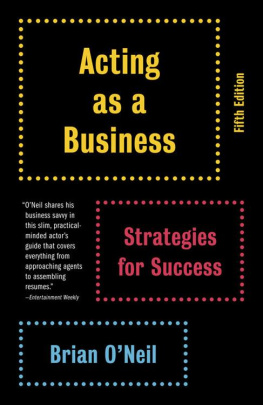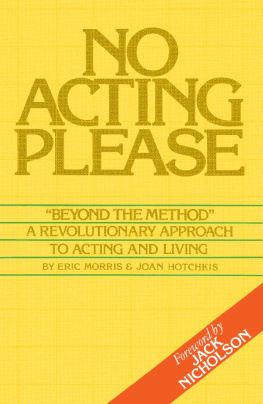This is a Genuine Vireo Book
A Vireo Book | Rare Bird Books
453 South Spring Street, Suite 302
Los Angeles, CA 90013
rarebirdbooks.com
Copyright 2018 by Sonya Cooke
All rights reserved, including the right to reproduce this book or portions thereof in any form whatsoever, including but not limited to print, audio, and electronic. For more information, address: A Vireo Book | Rare Bird Books Subsidiary Rights Department, 453 South Spring Street, Suite 302,
Los Angeles, CA 90013.
Set in Minion
epub isbn : 9781947856400
Publishers Cataloging-in-Publication data
Names: Cooke, Sonya, author.
Title: Seven pillars acting / Sonya Cooke.
Description: First trade paperback original edition | A Genuine Vireo Book | New York, NY; Los Angeles, CA: Rare Bird Books, 2018.
Identifiers: ISBN 9781945572937
Subjects: LCSH Acting. | ActingAuditions. | Screen tests. | Method (Acting). | ActingHandbooks, manuals, etc. | BISAC PERFORMING ARTS /
Acting & Auditioning
Classification: LCC PN2061 .C67 2018 | DDC 792/.028dc23
Contents
Introduction
There are two slogans that are crucial to keep in the forefront of the actors mind. They have a prominent place in my consciousness and often fly from my mouth faster than I can restrain them. The first slogan comes from the main inspiration for this technique:
Acting is living truthfully under imaginary circumstances .
Sanford Meisner
This is the golden rule of acting. As long as the actor is living in the circumstances of the character, acting is easeful and effortless. This leads us to an expression I often use:
To act is to transform with ease and authenticity.
The two slogans go hand in hand, as they both crystallize where the actors priorities must lie. Our craft is about setting up imaginative conditions that allow the actor to behave, speak, and feel as the character. Acting is not an escape; actors put themselves in the line of fire, exposing themselves to tremendously high stakes to tell a story. Integration, the harmonizing of the actor with the role, is vital. This is our ideal: to train the actor to live and breathe within his own body, mind, and spirit within the circumstances of his character.
Seven Pillars Acting is a comprehensive acting technique intended to help actors transform into character by living truthfully under imaginary circumstances. The Pillars strive to convey a path for the artist, but they do so with the utmost reverence for the pure spark of natural inspiration that occurs in the actor. The Seven Pillars do not replace that spark but coax it into a flame and, from there, into a hearth the artist can call home. Through the study of acting craft, we are harnessing and rearing that creative spark that ignites in childhood and early adulthood.
THE SEVEN PILLARS
- Contact
- Circumstance
- Meaning
- Emotional Life
- Objective
- Action
- Physical Life
Contact is the foundational pillar, pertaining to the ever-changing relationship an actor/character has with the other person in the scene. Envision it as a wide, short pillar on top of which our other pillars stand. As the base pillar, Contact supports the others, in that all acting is dependent on relationship. Circumstance is the luminescent, central pillar that dominates the technique. Circumstances are past, present, and future events of the scene as the character perceives them , which reveal the confines and contours of a characters point of view. With its roots planted firmly in the Contact pillar, its significance radiates through the structure. Surrounding Circumstance are the remaining five pillars. Meaning refers to the characters emotional interpretation of his circumstances. This pillar is smaller compared to the others, yet it serves an important function: it is the point at which the actor makes an honest assessment of his connection to the story. Stemming from Meaning, Emotional Life bridges the gap between the character and the actor through imaginative and emotional exploration. Once the actor is authentically connected to the world of the character, hes ready to do something about it, which brings us to Objective . The fifth pillar addresses the needs and wants of the character, and the Action pillar tends to the tactics the character uses to achieve his objective. The last pillar, Physical Life , deals with how the body and voice activate the actors imagination and contribute to characterization. Together, all seven pillars support the actors truthful performance, which balances effortlessly on top.
Seven Pillars Acting is deeply rooted in theories and techniques from the great acting teachers and theorists of the past and present, principally Sanford Meisner, Konstantin Stanislavski, Jerzy Grotowski, and Declan Donnellan. These ideas have passed through the hands and hearts of innumerable teachers, actors, and innovators, and I make every effort to give credit where it is due. Seven Pillars Acting attempts to organize and synthesize these disparate approaches into one modern and coherent process. And its unique approach to Circumstance serves as the cornerstone of the entire technique. The whole system hinges on the actors comprehension of it, as it is through the lens of Circumstance that all other pillars must be filtered.
Seven Pillars Acting arranges its lessons in such a way to give the actor a dependable and repeatable process. Actors need structure and order; all art forms are founded on this principle. And yet the pillars are pliable, which is why they are pillars , not steps. In other words, the actor-in-training learns them individually, one through seven, and after that he is free to enter into a role from any angle, which allows him to stay adaptable to the creative process and timeline. With Circumstance as the hub of the wheel, the pillars transform the way an actor approaches a role. When the actor perceives his part through the scope of Circumstance, then all other pillars become intuitive and accessible. In turn, he experiences greater ease as he negotiates the demands of the part.
Once learned and mastered, the pillars take organic shape in the actors craft. When I begin to work on a role, I attempt to listen to what the character and story are asking of me first, and from there I can build my process. Seven Pillars Acting allows for that flexibility, and yet I always know that if I get lost or confused, I can return to the fundamental progression the pillars lay out for me. Therefore, the actor must not be dogmatic about his technique, but rather be intuitive and open to what a role requires of him.
When your car breaks down, do you attempt to fix it yourself? If you are like me, you call a trusted mechanic on the double, because you have no idea what is under the hood. This is often the relationship actors have with their craft. When a performance breaks down, the actor doesnt know how to fix it, which may result in him needlessly criticizing himself and doubting his talent. In Seven Pillars Acting, you learn every inch of your process, so that you can address any issue that may come up. You should be able to depend on yourself, not a teacher or director, to fix your car-aft . That is artistic autonomy, and it is the goal for anyone studying this technique.
Ultimately, Seven Pillars Acting engenders confidence, ownership, and ease, three crucial elements in a performance. Particularly for the beginning actor, the pillars carve a clear path that leads to personal and artistic transformation. It is this confidence that empowers the actor to make bolder choices and to plumb greater depths of his humanity to offer to the character at hand. The easeful actor has tremendous presence; he belongs in the world of the character because he is authentically living within the imaginary circumstances.












